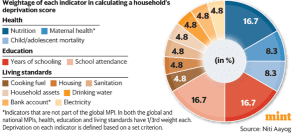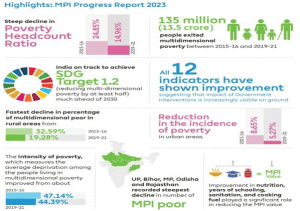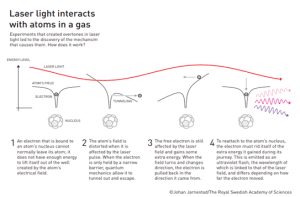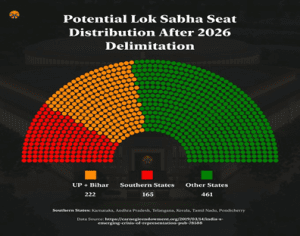THE CONTEXT: A groundbreaking report from the United Nations Food and Agriculture Organization (FAO), published earlier this month, has laid bare the staggering hidden costs of our global agrifood systems, surpassing an astonishing $10 trillion.
ABOUT AGRI-FOOD SYSTEMS
Agri-food systems have three main components:
- Primary production: It includes food from agricultural and non-agricultural origins, as well as non-food agricultural products.
- Food distribution: It links production to consumption through food supply chains and domestic food transport networks.
- Household consumption: It is the downstream outcome of functioning agrifood systems, subject to varying degrees of demand shocks.
HIGHLIGHTS OF THE STATE OF FOOD AND AGRICULTURE 2023 REPORT
- The report blames “unsustainable businessasusual activities and practices” for these escalating costs, pointing to a need to transform agrifood systems.
- In middle-income countries like India, these costs constitute nearly 11% of the GDP, which manifests as higher poverty, environmental harm, and health related impacts, including undernourishment and unhealthy dietary patterns.
- One way to do so is to shift to multi-cropping systems that have the potential to protect farmers’ well-being, improve nutritional outcomes for our communities, and positively impact ecological health.
IMPROVEMENTS IN AGRICULTURAL PRODUCTIVITY AND ITS IMPACT:
- Impressive improvements in agricultural productivity have been achieved in India over the last five decades by mainstreaming monocropping systems and chemicalintensive farming practices.
- The Green Revolution focused on the marketing of highyielding varieties of paddy and wheat on agricultural lands, which now constitute more than 70% of India’s agricultural production.
- The infusion of seeds purchased from multinational corporations and fertilizers undermined seed sovereignty, dismantled Indigenous knowledge systems, and fuelled a shift from diverse crop varieties and staples such as pulses and millets to monoculture plantations.
- This trend also compromised the nutritional needs of households and resulted in adverse ecological consequences including excessive extraction of groundwater.
- This privatisation and deregulation of agricultural inputs also increased indebtedness among agrarian households.
- In 2013, the debt to asset ratio of a farmer’s household in India was 630% higher than in 1992. Agriculture in India has increasingly become unviable:
- The average monthly household income of a farming household sits at ₹10,816.
THE CROPS BEING FAVOURED BY THE GOVERNMENT AND ITS ISSUES WITH IT
National Food Security Act 2013: 65% of households (around 800 million people) in India are legally assured a right to food at subsidised rates through the Public Distribution System and welfare programmes such as the Integrated Child Development Services and the Mid-Day Meal Scheme.
The Procurement of food crops: Procurement of food crops is coordinated by the Food Corporation of India (FCI), which is required to maintain a central pool of buffer stock and to procure, transport, and store foodgrain stocks in the country.
- However, this procurement policy heavily favours rice and wheat.
- In 20192020, the FCI procured 341.32 lakh million tonnes (MT) of wheat and 514.27 lakh MT of rice.
- Whole wheat and rice also became export commodities.
- Not surprisingly, the area under cultivation of coarse grains dropped by 20% between 1966-1967 and 2017-2018, whereas the area under rice and wheat increased by nearly 20% and 56% respectively.
Water-intensive cash crops: Water intensive cash crops like sugarcane and areca nut have also flourished under policies favouring investments in dams and canal irrigation (favourable for sugarcane) and free electricity for borewells (favourable for areca nut).
Threatens food security: Policies favour investments in water intensive cash crops, which threatens food security and the production of nutritional crops.
Affects Biodiversity: The expansion of sugarcane cultivation affects biodiversity, increases the pressure on groundwater resources, and contributes to air and water pollution.
Issues with small and marginal farmers: Small and marginal farmers in India are among the most food and nutrition insecure.
- The global food system structure has a direct impact on the last mile on both farmers and soil.
- Between 2012 and 2016, large fluctuations in soya prices in the global market and a glut in supply from Latin American countries eroded income for soy farmers and agro companies in Malwa.
- Historically as well, global trade relations have influenced food production systems in the Global South. In the pre-independence era, tax systems were introduced to efficiently collect revenue for British-enforced exports of primary raw materials, such as cotton.
HOW CAN CROP DIVERSIFICATION HELP?
Diversification of farms: A systemic shift in food regimes, from local to global value chains, is essential. The starting point for addressing these complex systemic issues could arise from local efforts, such as the diversification of farms.
Solution to revitalise degraded land and soil: Diversified multi-cropping systems, rooted in agroecology principles, could be a viable solution to revitalise degraded land and soil.
Improves soil health: Practices known by various names locally, like ‘akkadi saalu’ in Karnataka, involve intercropping with a combination of legumes, pulses, oilseeds, trees, shrubs, and livestock.
- This approach enables cash provision from commercial crops, food and fodder production, and offers ecosystem services such as nitrogen fixation and pest traps and supports the local biodiversity. They also collectively contribute to improving soil health.
FAO report: The FAO report says that there are substantial “hidden costs” associated with the current systems which need to be factored into long-term evaluations of income.
ISSUES WITH THE CROP DIVERSIFICATION
Arguments against alternative farming systems: Critics have often argued against alternative farming systems, suggesting they may lead to a decline in farmer income even if the environment improves.
Loss of productivity: While crop diversification will involve some loss of productivity using a narrow metric of kg/Ha, it would preserve natural capital and allow farmers to become nutritionally secure.
THE WAY FORWARD
Redirecting subsidies: By redirecting subsidies, currently accruing to corporations, we can pay farmers for their contribution to sustaining natural capital, instead of incentivising them to deplete it.
Systematic transition: It is unrealistic to expect farmers to shift away from mono-cultivation of rice and wheat overnight. This transition needs to be systematic, allowing farmers to adjust gradually.
- For instance, moving from chemical-intensive practices to non-pesticide management, then adopting natural farming practices, can reduce input costs.
Visual representation of a diversified: Among the various transition pathways, a visual representation of a diversified farm involves allocating 70% for commercial crops, 20% for food and fodder, and 10% for environmental services like oilseeds (acting as trap crops).
- Over time, the fraction of commercial crops could be lowered to 50% and border crops could be replaced with locally suitable tree species for fruits and fodder.
- Integrating livestock rearing could further improve incomes.
Addressing challenges related to local seeds: Addressing challenges related to local seeds, institutional arrangements for market access, drudgery, and the need for farm labour is crucial when envisioning such a transition.
Value addition: Farmers can diversify income through value addition, incorporating livestock and poultry. Some of these practices could be experimented with partially on specific portions of their lands.
Collaborating among institutions: Scaling up these practices requires collaboration among institutions, policymakers, and social groups to articulate economic incentives for farmers to shift from high-input monoculture to diversified cropping.
Focusing on millets: millets, whose yield per hectare is comparable to those of rice and wheat, are also more nutritious, grow in semi-arid conditions without burdening groundwater tables, require minimal input, and provide a diversified food basket.
CONCLUSION:
Shifting from the current high-input monoculture system to diversified cropping presents a crucial opportunity for environmental sustainability and improved farmer livelihoods. By implementing the proposed strategies, we can create a more resilient agricultural sector that benefits both farmers and the environment.
PREVIOUS YEAR QUESTIONS:
Q) What are the salient features of National Food Security Act, 2013? How has the Food Security Bill helped in eliminating hunger and malnutrition in India? (2021)
Q) What are the present challenges before crop diversification? How do emerging technologies provide an opportunity for crop diversification? (2021)
Q) What are the reformative steps taken by the Government to make the food grain distribution system more effective? (2020)
MAINS PRACTICE QUESTION:
Q) Examine the need for transforming the agri-food systems for ensuring food security, protecting soil fertility and reducing the food subsidy of the government.
SOURCE:https://epaper.thehindu.com/reader?utm_source=Hindu&utm_medium=Menu&utm_campaign=Header








